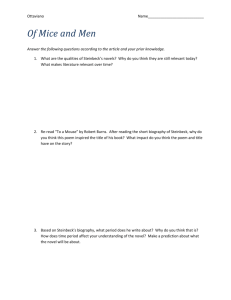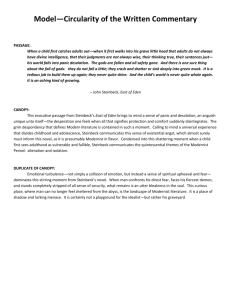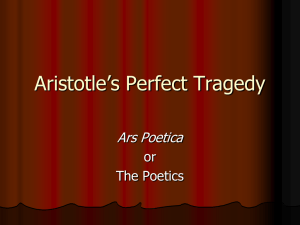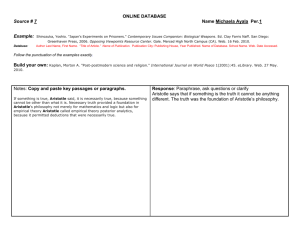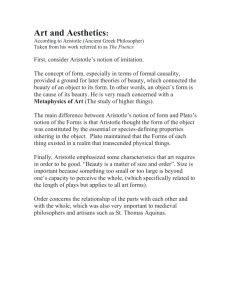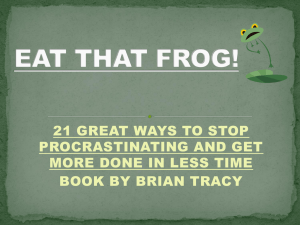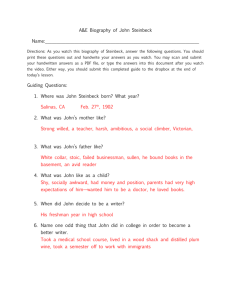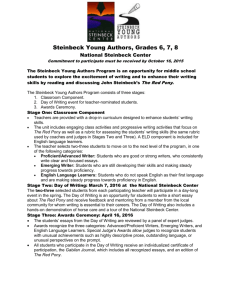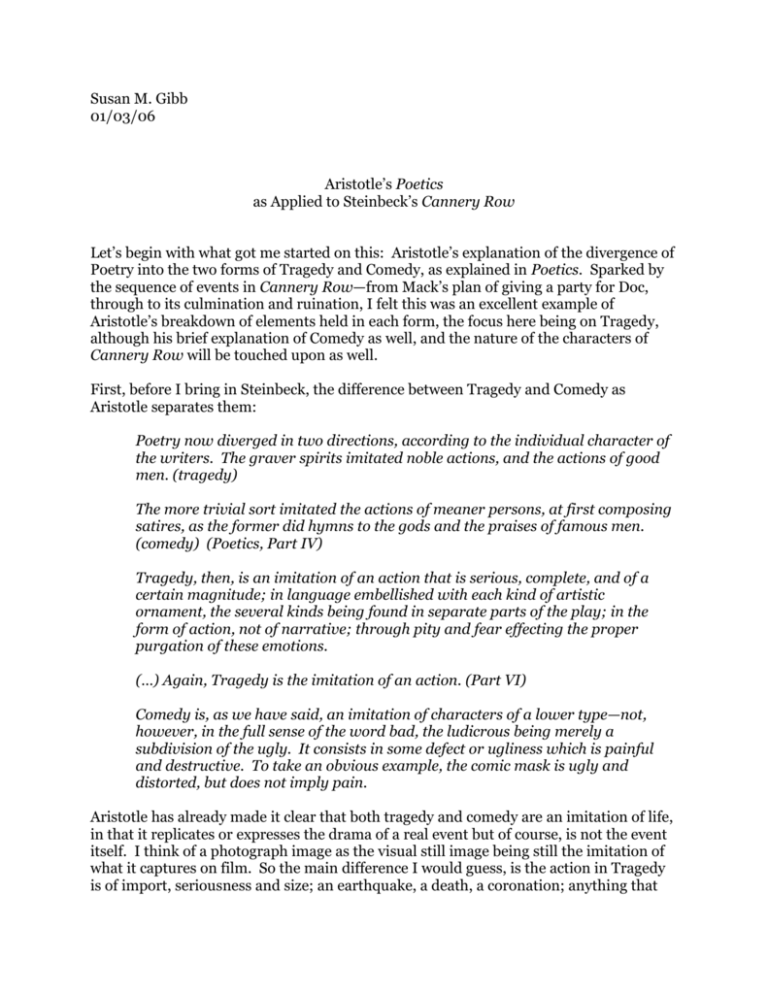
Susan M. Gibb
01/03/06
Aristotle’s Poetics
as Applied to Steinbeck’s Cannery Row
Let’s begin with what got me started on this: Aristotle’s explanation of the divergence of
Poetry into the two forms of Tragedy and Comedy, as explained in Poetics. Sparked by
the sequence of events in Cannery Row—from Mack’s plan of giving a party for Doc,
through to its culmination and ruination, I felt this was an excellent example of
Aristotle’s breakdown of elements held in each form, the focus here being on Tragedy,
although his brief explanation of Comedy as well, and the nature of the characters of
Cannery Row will be touched upon as well.
First, before I bring in Steinbeck, the difference between Tragedy and Comedy as
Aristotle separates them:
Poetry now diverged in two directions, according to the individual character of
the writers. The graver spirits imitated noble actions, and the actions of good
men. (tragedy)
The more trivial sort imitated the actions of meaner persons, at first composing
satires, as the former did hymns to the gods and the praises of famous men.
(comedy) (Poetics, Part IV)
Tragedy, then, is an imitation of an action that is serious, complete, and of a
certain magnitude; in language embellished with each kind of artistic
ornament, the several kinds being found in separate parts of the play; in the
form of action, not of narrative; through pity and fear effecting the proper
purgation of these emotions.
(…) Again, Tragedy is the imitation of an action. (Part VI)
Comedy is, as we have said, an imitation of characters of a lower type—not,
however, in the full sense of the word bad, the ludicrous being merely a
subdivision of the ugly. It consists in some defect or ugliness which is painful
and destructive. To take an obvious example, the comic mask is ugly and
distorted, but does not imply pain.
Aristotle has already made it clear that both tragedy and comedy are an imitation of life,
in that it replicates or expresses the drama of a real event but of course, is not the event
itself. I think of a photograph image as the visual still image being still the imitation of
what it captures on film. So the main difference I would guess, is the action in Tragedy
is of import, seriousness and size; an earthquake, a death, a coronation; anything that
wouldn’t make us sit and giggle in reaction, and nothing merely spoken as dialogue is
only in response to that action—the tragedy itself, however Thought and Character
which are elements of Tragedy, would indeed come into play in the tone of Tragedy in
their revealing properties.
Though I do not quite agree with Aristotle’s presentation of comedy as that of being less
noble, or being of the lower class (or character) of man, although he may indeed see
both sides within one man. And while he separates the writers by that nature as well, I
might argue this as a generalization, or as intimated, the dual nature of each individual.
But on to the analysis.
Focusing then on Tragedy, Aristotle breaks it down into the necessary elements, in order
of importance, and I will list them briefly here (all quotes taken from Poetics, Part VI):
Plot:
But most important of all is the structure of the incidents. For Tragedy is an
imitation, not of men, but of an action and of life, and life consists in action, and
its end is a mode of action, not a quality. (…) Again, without action there cannot
be a tragedy; there may be without character.
Character:
Character holds second place. (…) Character is that which reveals moral
purpose, showing what kinds of things a man chooses or avoids. Speeches
therefore, which do not make this manifest, or in which the speaker does not
choose or avoid anything whatever, are not expressive of character.
Thought:
Third in order is Thought – that is, the faculty of saying what is possible and
pertinent in given circumstances.
Speeches therefore, which do not make this manifest, or in which the speaker
does not choose or avoid anything whatever, are not expressive of character.
Thought on the other hand, is found where something is proved to be or not to
be, or a general maxim is enunciated.
Thought is required wherever a statement is proved, or, it may be, a general
truth enunciated.
Diction:
Fourth among the elements enumerated comes Diction; by which I mean, as has
already been said, the expression of the meaning in words; and its essence is the
same both in verse and prose. (…)
By Diction I mean the mere metrical arrangement of the words… (p. 5)
Song and Spectacle:
Of the remaining elements Song holds the chief place among the
embellishments. The Spectacle has, indeed, an emotional attraction of its own,
but of all the parts, it is the least artistic, and connected least with the art of
poetry. (…) Besides, the production of spectacular effects depends more on the
art of the stage machinist than on that of the poet.
Plot then, according to Aristotle, is to keep uppermost in the mind of the writer or teller
of story. The slow layering of cause and effect, the tying in of actions and reactions into
a developing whole will involve all the other elements of Tragedy. Steinbeck does this
exceptionally well. He introduces the setting and inserts the characters slowly within in.
The actions of the characters as individuals and in their interactions both in dialogue
and placement to each other begin early on to weave together separate strands into a
rope that pulls the reader through the narrative. We know it is leading somewhere. We
know there is something at the end of the rope because Steinbeck hints at a connection
between the characters above and beyond their normal relationships.
It would now be wise to lay out a summary of Cannery Row, of that particular sequence
that John Steinbeck built up within the structure of the story that follows Aristotle’s
expression of plot upon which I lay my concentration:
Cannery Row, The Story:
Mack gets the idea of repaying Doc for all his patience and help that he gives
freely to he locals, and decides to throw a surprise party for him. In order to
cover expenses, he checks with Doc and finds that Doc needs at least 300 frogs to
fill an order, but that he also needs to personally take a day trip to fill an order for
baby octopi. Mack manages to talk the tough Lee Chong into loaning them his
truck if they’ll fix it, and Mack and the boys take off to a special place, planning
on getting closer to 800 frogs by nightfall. The truck breaks down on the ride, the
mechanic of the group, Guy, takes off to buy a part and never returns, the boys
are caught camping by a landowner and, with Mack’s silver tongue and offer to
help heal the gentleman’s hunting dog, they end up partying with him. The
landowner directs them to get the frogs from his pond, and loaded down, they
happily return to town where they finagle with Lee Chong for groceries, liquor
and party decorations by trading the frogs to him at an increased value of
25/$1.00 rather than the 20/$1.00 that Doc pays. The party starts and ends
before Doc gets home, and he walks into a house wrecked by the partygoers and
all the frogs have escaped.
Meanwhile, Doc goes off into an adventure of his own. He eats his way along the
journey, picks up a hitchhiker who annoys him enough to finally try a beer
milkshake. When he finds a great spot for baby octopi, he lifts a rock in the water
to reveal the dead face of a young woman. He comes home exhausted into a
disaster.
Lee Chong gets his truck back safely, has been paid in frogs and expects to make a
small profit from reselling them to Doc as well as received the profit back as the
boys buy all their supplies at a premium. But in the end his frogs are lost.
Mack comes back to the lab to apologize to Doc, wherein Doc throws a few
punches out of frustration and anger to Mack’s willingness to accept his
punishment and the two acknowledge themselves for who they are, able to
maintain the friendship.
Now to examine the elements as proposed by Aristotle by analyzing an example from
Steinbeck’s Cannery Row.
Plot:
The steps in the plan that leads to the event or climax and resolution is plot, in the case
of this sequence of Cannery Row, the setting off and merging of the paths that steadily
lead up to the foretold event of the party.
Steinbeck:
The boys could sit in front of their door and look down across the track and
across the lot and across the street right into the front windows of Western
Biological. They could hear the music from the laboratory at night. And their
eyes followed across the street when he went to Lee Chong’s for beer. And Mack
said, “That Doc is a fine fellow. We ought to do something for him. (Cannery
Row, p. 16)
(Mack goes to see Doc, to get a job to get money for the party):
Now Doc really needed the frogs. He tried to work out some method which was
business and not philanthropy. “I’ll tell you what I’ll do,” he said. “I’ll give you a
note to my gas station so you can get ten gallons of gas. How will that be?”
Mac smiled. “Fine,” he said. “That will work out just fine. I and the boys will get
an early start tomorrow. Time you get back from the south, we’ll have more
damn frogs than you ever seen in your life.” (p. 52)
(On to Lee Chong’s, to borrow his truck):
Mack wasted no time in sparring. “Lee,” he said, “Doc over there’s got a
problem. He’s got a big order for frogs from the New York Museum. Means a
lot to Doc. Besides the dough, there’s a lot of credit getting an order like that.
Doc’s got to go south and I and the boys said we’d help him out. I think a guy’s
friends ought to help him out of a hole when they can, especially a nice guy like
Doc. Why I bet he spends sixty, seventy dollars a month with you.” (p. 53)
(They reach their destination):
Mack and the boys came down to this place happily. It was perfect. If frogs
were available, they would be here. It was a place to relax, a place to be happy.
On the way out they had thriven. In addition to the big red chicken there was a
sack of carrots which had fallen from a vegetable truck, half a dozen onions
which had not. Mack had a bag of coffee in his pocket. In the truck there was a
five-gallon can with the top cut off. The wining jug was nearly half full. Such
things as salt and pepper had been brought. Mack and the boys would have
thought anyone who traveled without salt, pepper, and coffee very silly indeed.
(p. 73)
(After a brief episode with a landowner, they catch their frogs and return, making a plan
to barter frogs for groceries and liquor at Lee Chong’s):
“We don’t want you to have a mortgage on frogs.” Mack went on. “We will
actually deliver right into your hands twenty-five frogs for every buck of
grocers you let us have and you can come to the party too.” (p. 111)
His (Mack) voice grew mellow and his eyes looked into the future. “I can just see
it,” he said. “Doc comes home. He’s tired. He drives up. The place is all lit up.
he thinks somebody’s broke in. He goes up the stairs and by God the place has
got the hell decorated out of it. There’s crepe paper and there’s favors and a big
cake. Jesus, he’d know it was a party then. And it wouldn’t be no little mouse
fart party neither. And we’re kind of hiding so for a minute he don’t know who
done it. and then we come out yelling. Can’t you see his face? (p. 114)
(Where it all leads):
As the afternoon and the whiskey went down the enthusiasm rose. There were
endless trips to Lee Chong’s. The frogs were gone from one sack and Lee’s
packing case was getting crowded. By six-o-clock they had finished the gallon
of whiskey and were buying half pints of Old Tennis Shoes at fifteen frogs a
crack, but the pile f decorating materials was heaped on the floor of the Palace
Flophouse—miles of crepe paper commemorating every holiday in vogue and
some that had been abandoned. (p. 116)
(Doc finally comes home and confronts Mack):
For the moment Doc hadn’t seemed to see him. Now he leaped to his feet. Mack
shuffled backward. “Did you do this?”
“Well, I and the boys—” Doc’s small hard fist whipped out and splashed against
Mack’s mouth. Doc’s eyes shone with a red animal rage. Mack sat down
heavily on the floor. Doc’s fist was hard and sharp. Mack’s lips were split
against his teeth and one front tooth bent sharply inward.
(…) Mack was in the toilet cleaning his bloody face with wet paper towels. Doc
opened a bottle and poured gently into a glass, holding it at an angle so that
very little collar rose to the top. He filled a second tall glass and carried the two
into the front room.
(…) “What happened?” he asked.
Mack looked at the floor and a drop of blood feel from his lips into his beer. He
mopped his split lips again. “I and the boys wanted to give you a party. We
thought you’d be home last night.”
Doc nodded his head. “I see.”
“She got out of hand,” said Mack. (Cannery Row, p. 122-124)
Aristotle:
But most important of all is the structure of the incidents, and life consists in
action, and its end is a mode of action, not a quality. (Poetics, Part VI)
Steinbeck carefully builds the sequence of his plots to lead towards the event of the
party, all the while employing the use of the other elements of Character, Thoughts, etc.
to enhance and mold the structure that leads from point A to point B, or the completion
of the whole. Steinbeck uses Aristotle’s theory of incidents to bring the characters
through their journey while offering them opportunities for action and reaction to the
events. The plan for the party is almost foiled many times; no money, no wheels, the
truck they manage to borrow breaks down, the mechanic takes off, a landowner wants
them off his property, they drink all the booze, they trade all the frogs, Doc is late, the
party grows and prospers to a drunken brawl, Doc’s lab is wrecked, and—the frogs hop
happily away to freedom.
One action must lead to another, and each action must be dependent upon the prior to
be believable.
Aristotle: (on plot)
Of all plots and actions, the episodic are the worst. I call a plot ‘episodic’ in
which the episodes or acts succeed one another without probable or necessary
sequence.
But again, Tragedy is an imitation not only of a complete action, but of events
inspiring fear or pity. Such an effect is best produced when the events come on
us by surprise; and the effect is heightened when, at the same time, they follow
as cause and effect. (Poetics, Part IX)
Cannery Row seems to be a series of unrelated events as Steinbeck introduces
characters into the story. But we come to find that they are not episodes without
probable or necessary sequence as Aristotle warns, but a gradual picking of flowers into
a bouquet. Each character is revealed before his place in the plot is set. Each incident is
necessary to happen to bring about the next. Gay the mechanic must first fix the truck
and then abandon the group, and Steinbeck has laid the groundwork of his marital
problems as to why he would.
Aristotle:
Plots are either Simple or Complex, for the actions in real life, of which the plots
are an imitation, obviously show a similar distinction. An action which is one
and continuous in the sense above defined, I call Simple, when the change of
fortune takes place without Reversal of the Situation and without Recognition.
A complex action is one in which the change is accompanied by such Reversal,
or by Recognition, or by both. These last should arise from the internal
structure of the plot, so that what follows should be the necessary or probable
result of the preceding action. It makes all the difference whether any given
event is a case of propter hoc or post hoc. (Poetics, Part X)
Reversal of the Situation is a change by which the action veers round to its
opposite, subject always to our rule of probability or necessity. (Poetics, Part
XI)
I would say Mack’s plan of throwing a party for Doc, and the chain of events that take
them through its probability, and its ultimate disaster is a prime example of Aristotle’s
suggested Reversal of the Situation. A good intention gone wrong. Mack’s great idea
backfires horribly and the exact opposite is the result; instead of pleasing Doc, he has
seriously angered him.
This single excerpt below from Cannery Row exemplifies more concisely plot structure,
in that Steinbeck actually relates the sub-plot of one path of one character within the
overall plot structure of the party plan. The background is when Mack and the boys are
on their trip to collect the frogs and the truck breaks down. Gay, the mechanic, decides
to walk for help but never returns:
Steinbeck:
Oh the infamy of possibility! How could it happen that the car that picked up
Gay broke down broke down before it got to Monterey? If Gay had not been a
mechanic, he would not have fixed the car. If he had not fixed it, the owner
wouldn’t have taken him to Jimmy Bruscia’s for a drink. And why was it
Jimmy’s birthday? Out of all the possibilities in the world—the millions of
them—only events occurred that lead to the Salinas jail. Sparky Enea and Tony
Colletti had made up a quarrel and were helping Jimmy to celebrate his
birthday. The blonde came in. The musical argument in front of the jukebox.
Gay’s new friend who knew a judo hold and tried to show it to Sparky and got
his wrist broken when the hold went wrong. The policemen with a bad
stomach—all unrelated, irrelevant details and yet all running in one direction.
Fate just didn’t intend for Gay to go on that frog hunt and Fate took a hell of a
lot of trouble and people and accidents to keep him from it. (Cannery Row, p.
66)
The above is interesting in how, from within the structure of story, Steinbeck tells us
that he knows how plot should behave, one thing happening because of another, with
the conflicts arising as “unrelated, irrelevant details (and yet) all running in one
direction” conspire to produce action that Aristotle calls Tragedy.
Character:
In Cannery Row, Mack is the unspoken leader of a small group of friends, all
unemployed and industrious and ambitious only to the extent of survival techniques.
Doc, intelligent, philosophical, and kind, lives at and runs a lab where he does research
but mainly collects specimens for resale to larger labs. Lee Chong is a shrewd merchant
who runs the grocery and sundry store in the neighborhood. These are the three main
characters, and they are inextricably tied into the main plot while they go off on three
separate paths of story (Lee Chong to a lesser degree—following his normal routine as
established previously by Steinbeck) that will meet as foreshadowed by the “plan.”
Steinbeck:
At last Mack said, “God damn it. I hate a liar.”
“Who’s been lyin’ to you?” Eddie asked.
“Me,” said Mack. “And maybe you guys. Here we are,” he said earnestly, “the
whole God damned shabby lot of us. We worked it out that we wanted to give
Doc a party. So we come out here and have a hell of a lot of fun. Then we’ll go
back and get the dough from Doc. There’s five of us, so we’ll drink five times as
much liquor as he will. And I ain’t sure we’re doing it for Doc. I ain’t sure we
ain’t doin’ it for ourselves. And Doc’s too nice a fella to do that to. Doc is the
nicest fell I ever knew. I don’t want to be the kind of guy that would take
advantage of him. (p. 77)
Of character, Aristotle claims, that it must be presented in a consistent manner, the
other elements being that it must be good, show propriety, and remain true to life.
Aristotle:
In respect of Character there are four things to be aimed at. First, and most
important, it must be good. Now any speech or action that manifests moral
purpose of any kind will be expressive of the character; the character will be
good if the purpose is good. This rule is relative to each class. (Poetics, Part XV)
He goes on, though I would disagree with his eral (my word, of the era) view, and so
refuse to highlight it, that “Even a woman may be good, and also a slave; though the
woman may be said to be an inferior being, and the slave quite worthless.
From the example given, we see that Steinbeck gives us the Character of Mack as clever,
willing to bend the truth just enough to cause another to respond in a positive manner.
His intent of pleasing Doc is most certainly of good moral purpose, and he even
questions his own right to take such pleasure in it that it possibly overwhelms his gift in
benefit to Doc.
Aristotle:
As in the structure of the plot, so too in the portraiture of character, the poet
should always aim either at the necessary or probable. Thus a person of a given
character should speak or act in a given way, by the rule either of necessity or of
probability; just as this event should follow that by necessary or probable
sequence. (Poetics, Part XV)
Now character determines men’s qualities, but it is by their actions that they are
happy or the reverse. (Poetics, Part VI)
Aristotle suggests that in Tragedy, what is more likely to offer the fear and pity comes
from a flaw in human nature of one who is above in intelligence or noble manner. He
also notes that Tragedy, in focusing on the noble, paints men to be better than they are,
as in classical (and Renaissance) paintings, versus satire or parody found in Comedy.
Mack is, despite his status which would probably not fill Aristotle’s sketch of the hero, a
thoughtful, caring and simple man. He maneuvers to help himself and his friends only
to fulfill need, and he manipulates only those like Lee Chong who both have what he
needs and are, while not unscrupulous, might take advantage of others for personal
gain.
Aristotle:
It follows plainly, in the first place, that the change of fortune presented must
not be the spectacle of a virtuous man brought from prosperity to adversity: for
this moves neither pity nor fear; it merely shocks us. Nor again, that of a bad
man passing from adversity to prosperity: for nothing ca be more alien to the
spirit of Tragedy; it possesses no single tragic quality; it neither satisfies the
moral sense nor calls forth pity or fear. Nor, again, should the downfall of the
utter villain be exhibited. A plot of this kind would, doubtless, satisfy the moral
sense but it would inspire neither pity nor fear; for pity is aroused by unmerited
misfortune, fear by the misfortune of a man like ourselves. Such an event,
therefore, would be neither pitiful nor terrible. There remains, then, the
character between these two extremes—that of a man who is not eminently
good and just, yet whose misfortune is brought about not by vice or depravity,
but by some error or frailty. He must be one who is highly renowned or
prosperous—a personage like Oedipus, Thyestes, or other illustrious men of such
families. (Poetics, (Part XIII)
Mack’s best intentions are thwarted by his inability to overcome his penchant for drink
and good times with his friends. This is perhaps the personal flaw that Steinbeck
foreshadows in the scenarios between Mack and Lee Chong, Mack and Doc, etc. Mack is
clever rather than ambitious. This, according to Aristotle, would sooner be a trait of a
lesser man, one portrayed in Comedy rather than the noble hero of Tragedy. But in this
day, where we are more accepting of human nature perhaps (or perhaps not!), we see
both the comedic as well as tragic results of Mack’s efforts and accept and react to them
kindly. He is, however, a man like ourselves, “a man who is not eminently good and
just, yet whose misfortune is brought about not by vice or depravity, but by some error
or frailty.” (Poetics, Part III)
To go back to Aristotle’s initial explanation of Character, “Character is that which
reveals moral purpose, showing what kinds of things a man chooses or avoids,” we can
recognize that a good part of the actions that led from planning stage to party disaster
were of choices made by Mack that were questionable at best. While he has the best of
meaning to honor Doc, he falls prey to his own weaknesses in allowing the revelry to
begin prior to Doc’s arrival. He has foreseen this, worries about it, yet it comes to be.
How then would we judge him by Aristotle’s standards of moral character? Is action
more important than thought; is it more indicative of true character?
Thought:
As with Character, Thought must be consistent and that of which is good or noble within
the character, and “the faculty of saying what is possible and pertinent in given
circumstances.”
Taking this to mean what Steinbeck allows his characters I would apply it to Mack’s
planning of the party, his knowledge of people, his plotting and manipulating to get just
what he needs and no more is based, I think, in a general goodness of intent. I would
propose that the plot in this sequence of events is led by Thought, and employ “The best
laid schemes o’ mice an’ men / Gang aft a-gley.” (“The best laid plans of mice and men
often go awry”) (Burns, Robert, To a Mouse) as the theme of Thought here, that
displays both character and action.
Steinbeck:
“No, but it’s nice,” said Mack. “I figure it would take ten or twelve bucks to give
Doc a party you wouldn’t be ashamed of.”
They looked at one another speculatively. Hughie suggested, “The Hediondo
Cannery is hiring guys.”
“No,” said Mack quickly. We got good reputations and we don’t want to spoil
them. Every one of us keeps a job for a month or more when we take one.
That’s why we can always get a job when we need one. S’pose we take a job for
a day or so—why we’ll lose our reputation for sticking. Then if we needed a job
there wouldn’t nobody have us.” The rest nodded quick agreement. (Cannery
Row, p. 45)
Aristotle:
Under Thought is included every effect which has to be produced by speech, the
subdivisions being: proof and refutation; the excitation of the feelings, such as
pity, fear, anger, and the like; the suggestions of importance or its opposite.
Now, it is evident that the dramatic incidents must be treated from the same
points of view as the dramatic speeches, when the object is to evoke the sense of
pity, fear, importance, or probability. (…) For what were the business of a
speaker, if the Thought were revealed quite apart from what he says? (Poetics,
Part XIX)
While this excerpt from Cannery Row might not be the best example, it precludes the
plot and is the central point of the action which lies ahead. It reflects Mack’s
appreciation of Doc, and the honest intention to repay kind acts of the past. I would
think that it fulfills Aristotle’s element of evoking importance and probability—that of
the planning and possibility of culmination, while foreshadowing the sense of fear and
pity that we have come to expect from Steinbeck’s previous glimpses into the actions
and dealings of Mack that has given us some feel for his character.
Diction:
I chose as an example of Diction the imagery in description that Steinbeck inserts
appropriately to enliven the action and dialogue by its poetic nature. Both the local
language Steinbeck allows his characters that ground them in a realism of character and
place and the expression of action in a crisp and down to earth manner are set with
words that are strung together to enlighten as well as charm, and yet it is the spaces
where Steinbeck allows us to stop and linger that he brings us to full appreciation of all
facets of language.
Aristotle:
The perfection of style is to be clear without being mean. The clearest style is
that which uses only current or proper words; at the same time it is mean—
witness the poetry of Cleophon and of Sthenelus. That diction, on the other
hand, is lofty and raised about the commonplace which employs unusual words.
(Poetics, Part XXII)
It is a great matter to observe propriety in these several modes of expression as
also in compound words, strange (or rare) words, and so forth. But the
greatest thing by far is to have a command of metaphor. This alone cannot be
imparted by another; it is the mark o a genius, for to make good metaphors
implies an eye for resemblances. (Part XXII)
Steinbeck:
Doc was collecting marine animals in the Great Tide Pool on the tip of the
Peninsula. It is a fabulous place: when the tide is in, a wave-churned basin,
creamy with foam, whipped by the combers that roll in from the whistling buoy
on the reef. But when the tide goes out, the little water world becomes quiet and
lovely. The sea is very clear and the bottom becomes fantastic with hurrying,
fighting, feeding, breeding animals. Crabs rush from frond to frond of the
waving algae. Starfish squat over mussels and limpets, attaché their million
little suckers and then slowly lift with incredible power until the prey is broken
from the rock. And then the starfish stomach comes out and envelops its food.
Orange and speckled and fluted nudibranches slide gracefully over the rocks,
their skirts waving like the dresses of Spanish dancers. And black eels poke
their heads out of crevices and wait for prey. The snapping shrimps with their
trigger claws pop loudly. The lovely colored world is glassed over. Hermit
crabs like frantic children scamper on the bottom sand. And now one, finding
an empty snail shell he likes better than his own, creeps out exposing his soft
body to the enemy for a moment, and then pops into the new shell. A wave
breaks over the barrier and churns the glassy water for a moment and mixes
bubbles into the pool, and then it clears and is tranquil and lovely and
murderous again. (Cannery Row, p. 31)
Steinbeck is capable of extraordinary imagery and poetry within his descriptions, as well
as using several of the poetic techniques such as simile, alliteration, metaphor,
personification, sentence structure and length, and rhythm as Aristotle claims is a
necessary part of Tragedy. The above excerpt can be readily transformed with little
effort into verse and stanza, for the meter, the beat is there as easily as the imagery.
While there is much more to say about diction, that would be a whole separate essay on
this element alone to better explain Aristotle’s precise breakdowns and explanations.
Steinbeck is a writer of extraordinary talent and to take it lightly here would be
sacrilegious and dishonor both gentlemen by offering such analysis without serious
depth and attention given.
Song:
As for Song, there are a couple ways to apply Aristotle’s element of song, which while
based on the Tragedies of the time included chorus that he felt should enhance rather
than simply tie together the scenes, are more relative to audio visual mediums than text,
but perhaps I can tweak it a bit to text.
Steinbeck:
Early morning is a time of magic in Cannery Row. In the gray time after the
light has come and before the sun has risen, the Row seems to hang suspended
out of time in a silvery light. The street lights go out, and the weeds are a
brilliant green. The corrugated iron roof the canneries glows with the pearly
lucence (luminescence?) of platinum or old pewter. No automobiles are running
then. The street is silent of progress and business. And the rush and drag of the
waves can be heard as they splash in among the piles of the canneries. It is a
time of great peace, a deserted time, a little era of rest.” (Cannery Row, p. 81)
Does this not sing of tone and rhythm of the place in which the action is about to take
hold? I would argue that the language used by Steinbeck in his descriptions—while
falling under the element of Diction—is as musical and lyrical as would be set to strings
whether on a Greek Tragedy stage or set within the film process as audio effects to
enhance drama and moment.
Aristotle:
The Chorus too should be regarded as one of the actors; it should be an integral
part of the whole, and share in the action, in the manner not of Euripides but of
Sophocles. As for the later poets, their choral songs pertain as little to the
subject of the piece as to that of any other tragedy. They are, therefore, sung as
mere interludes—(Poetics, Part XVIII)
The narrative should then be related to the Tragedy itself, and it certainly seems that by
choice of language here in producing setting for the plot, Steinbeck is following in words
what Aristotle seeks in performance.
I might also go more directly to Steinbeck’s portrayal of Doc as a man who listens to
music, hears it in his head when not played by mechanical means, and so is dependent
upon it as a necessary part of his character, i.e., the loneliness Doc feels in the crowd,
how the music comes to him when needed, i.e., seeing the face of the dead woman in the
water when he is collecting the baby octopi, or here, when he is dealing with the
aftermath of Mack’s attempts to please him with the party:
Steinbeck:
Mack sat down on the chair and looked at him. Mack’s eyes were wide and full
of pain. He didn’t even wipe away the blood that flowed down his chin. In Doc’s
head the monotonal opening of Monteverdi’s Hor ch’el Ciel e la Terra began to
form, the infinitely sad and resigned mourning of Petrarch for Laura. Doc saw
Mack’s broken mouth through the music, the music that was in his head and in
the air. Mack sat perfectly still, almost as though he could hear the music too.
Doc glanced at the place where the Monteverdi album was and then he
remembered that the phonograph was broken. (Cannery Row, p. 123)
Certainly if this novel were set to stage, we would hear it as well. Aristotle’s intent for
the chorus to not merely fill in the places between scenes but rather to become part of
the Tragedy by tone and dramatic effect is working here in Steinbeck’s Cannery Row as
well.
Spectacle:
As Aristotle notes, Tragedy is aided by the use of Spectacle, which on stage may be
props, costume, etc., whatever seeks by embellishment to assist the image and tone of
the drama. What I select here as example of Spectacle is the catching of the frogs.
Aristotle’s suggestion of magnitude might be filled by the multitude of frogs, I would
think, and the splashing of both amphibian and human does of battle, one-sided though
it be. Why battle rather than hunt? Not only to satisfy Aristotle’s stipulation of
importance of effect, but because Steinbeck gives us historical background of this
ongoing clash:
Steinbeck:
During the millennia that frogs and men have lived in the same world, it is
probably that men have hunted frogs. And during that time a pattern of hunt
and parry has developed. The man with net or bow or lance or gun creeps
noiselessly, as he thinks, toward the frog. The pattern requires that the frog sit
still, sit very still and wait. The rules of the game require the frog to wait until
the final flicker of a second, when the net is descending, when the lance is in the
air, when the finger squeezes the trigger, then the frog jumps, plops into the
water, swims to the bottom and waits until the man goes away. That is the way
it is done. Frogs have every right to expect it will always be done that way.
Now and then the net is too quick, the lance pierces, the gun flicks and that frog
is gone, but it is all fair and in the framework. Frogs don’t resent that. But how
could they have anticipated Mack’s new method? How could they have foreseen
the horror that followed? The sudden flashing of lights, the shouting and
squealing of men, the rush of feet. Every frog leaped, plopped into the pool, and
swam frantically to the bottom. Then into the pool plunged the line of men,
stamping, churning, moving in a crazy line up the pool, flinging their fee about.
Hysterically the frogs displaced from their placid spots swam ahead of the
crazy thrashing feet and the feet came on. Frogs are good swimmers but they
haven’t much endurance. Down the pool they went until finally they were
bunched and crowded against the end. And the feet and wildly plunging bodies
followed them. A few frogs lost their heads and floundered among the feet and
got through and these were saved. But the majority decided to leave this pool
forever, to find a new home in a new country where this kind of thing didn’t
happen. A wave of frantic, frustrated frogs, big ones, little ones, brown ones,
green ones, men frogs and women frogs, a wave of them broke over the bank,
crawled, leaped, scrambled. they clambered up on the grass, they clutched at
each other, little ones rode on big ones. And then—horror on horror—the
flashlights found them. (Cannery Row, p. 89)
Man, is that a battle scene tantamount to a modern day galactic Star Wars or what? The
sound of battle, the fear, the pity as Tragedy demands—it is all here. Aristotle looks to
Spectacle as an embellishment, and the least important of the elements of Tragedy as
“the production of spectacular effects depends more on the art of the stage machinist
than on that of the poet.”
Aristotle:
Fear and pity may be aroused by spectacular means; but they may also result
from the inner structure of the piece, which is the better way, and indicates a
superior poet. For the plot ought to be so constructed that, even without the aid
of the eye, he who hears the tale told will thrill with horror and melt to pity at
what takes place. (Poetics, Part IV)
It appears that while the Spectacle of the frogs being caught is most certainly of epic
need, the inclusion of this episode has been properly built up to as an event in itself by
Steinbeck in the previous plotting of the story. And in words, he has been able to
produce the image of action in the reader’s mind that rivals the abilities of the special
effects of film making. The spectacle itself may induce horror, but the reader knows
something will go wrong, and Steinbeck again uses Spectacle less as embellishment but
more as a foreshadowed action to evoke the necessary pity and horror at the end of the
sequence, when the party goes all wrong:
Steinbeck:
No one has studied the pathology of a dying party. It may be raging, howling,
boiling, and then a fever sets in and a little silence and then quickly quickly it is
gone, the guests go home or go to sleep or wander away to some other affair
and they leave a dead body.
(…) Through the broken end of the packing case a frog hopped and sat feeling
the air for danger and then another joined him. They could smell the fine cool
damp air coming in the door and in through the broken windows. One of them
sat on the fallen card which said, “Welcome Home, Doc.” And then the two of
them hopped timidly toward the door.
For quite a while a little river of frogs hopped down the steps, a swirling,
moving river. For quite a while Cannery Row crawled with frogs—was overrun
with frogs. A taxi which brought a very late customer to the Bear Flag
squashed five frogs in the street. But well before dawn they had all gone. Some
found the sewer and some worked their way up the hill to the reservoir and
some went into culverts and some only hid among the weeds in the vacant lot.
And the lights blazed in the quiet empty laboratory. (Cannery Row, p. 119)
This time, spectacle serves as the climax of the story. All the conflicts of movement
toward this end, all the thinking, planning, action and events that led up to this moment
have ended here. Even Doc’s eventual homecoming to this disaster and his facing Mack
are resolution to the high point of drama as the frogs escape.
I certainly feel the horror and pity of it all.
CONCLUSION:
Poetics is a treatise on Narrative, focusing on Tragedy versus Comedy, and further
dividing Tragedy into its “play” and Epic poetry. Aristotle isn’t making up rules for
narrative, but rather dealing with what had been done successfully as he had observed
what was offered. There is much to say here about human nature, then, and what
appeals to it in way of story, as we can see that what worked in the time of Aristotle (and
before him) still works today.
We don’t know if John Steinbeck ever read Poetics and certainly could guess that he did
not write Cannery Row with the thought in mind to form his narrative according to its
rules. But the formula presented by Aristotle shows up in Steinbeck’s writing, whether
based on it directly or indirectly as it surely has influenced all writing and writing
instruction since its proposal.
The plot, noted by Aristotle as being of prime importance in a time when stageplays
were the chief form of story is still as vital in today’s world of film and illustration. Text
uses the same elements of Character, Thought, Diction, Song and Spectacle to enhance
Plot via language and skillful use thereof.
It would have been better perhaps to focus on one element alone to be able to bring out
all the points in Aristotle’s lecture, as well as the nuances in Steinbeck’s writing. A point
by point reference and study would well be worth the effort and more telling of the
statement of this thesis.
But this analysis was not meant to be a thesis, but rather an observation and simple
posting in weblog form; therefore, the lack of formal structure and argument. However
self-serving this brief and unchartered journey with Aristotle and Steinbeck has been, it
can serve as a reference in the future, a plan for further development into the analysis of
either work, Poetics or Cannery Row, and has performed a function of organizing for
consideration further thought into the elements of story.
Closer study, more concentrated and intimate detailing of the elements of Tragedy as
Aristotle demonstrates them would indeed prove, I believe, that while writers—or
poets—will reach beyond the rules to achieve effect, the base that Poetics gives us, if
understood and followed however loosely, will offer some support in the means to
produce outstanding literature such as that of Steinbeck’s Cannery Row.
Works Cited
Aristotle. Poetics. Translated by S. H. Butcher. Internet Classics Archive by
C. Stevenson, Web Atomics: Copyright 1994-2000.
http://classics.mit.edu//Aristotle/poetics/html
Daniel
Burns, Robert, To a Mouse, The New Dictionary of Cultural Literacy, Third
Edition. Edited by E.D. Hirsch, Jr., Joseph F. Kett, and James Trefil.
Copyright © 2002 by Houghton Mifflin Company. Published by Houghton
Mifflin Company. All rights reserved
HYPERLINK "http://www.bartleby.com/59/3/bestlaidplan.html"
http://www.bartleby.com/59/3/bestlaidplan.html
Steinbeck, John, Cannery Row. Ed. 5. New York, N.Y.: Penguin Books, 1994.
Steinbeck, John, Of Mice and Men. First published in the UnitedStates of America.
1936: Reissued in Penguin Books 1986 Copyright John
Steinbeck, 1937 Copyright
renewed John Steinbeck, 1965
HYPERLINK
"http://www.ac.wwu.edu/~stephan/Steinbeck/mice.html"
http://www.ac.wwu.edu/~stephan/Steinbeck/mice.html
PAGE
PAGE 17

